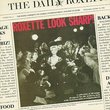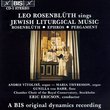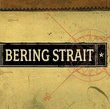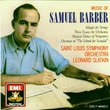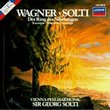| All Artists: Samuel Barber, Leonard Slatkin, Saint Louis Symphony Orchestra, John Browning Title: Samuel Barber: Symphony No. 1/Piano Concerto/Souvenirs Members Wishing: 0 Total Copies: 1 Label: RCA Release Date: 5/10/1991 Genre: Classical Styles: Forms & Genres, Concertos, Historical Periods, Modern, 20th, & 21st Century, Instruments, Keyboard, Symphonies Number of Discs: 1 SwapaCD Credits: 1 UPC: 090266073221 |
Search - Samuel Barber, Leonard Slatkin, Saint Louis Symphony Orchestra :: Samuel Barber: Symphony No. 1/Piano Concerto/Souvenirs
 | Samuel Barber, Leonard Slatkin, Saint Louis Symphony Orchestra Samuel Barber: Symphony No. 1/Piano Concerto/Souvenirs Genre: Classical
Both major works on this release are rarely performed and rarely recorded--but they shouldn't be. The First Symphony can stand right beside Aaron Copland's Third Symphony and Roy Harris's Third Symphony. In fact, Barber'... more » ![header=[] body=[This CD is available to be requested as disc only.]](/images/attributes/disc.png?v=15401716) ![header=[] body=[This CD is available to be requested with the disc and back insert.]](/images/attributes/disc_back.png?v=15401716) ![header=[] body=[This CD is available to be requested with the disc and front insert.]](/images/attributes/disc_front.png?v=15401716) ![header=[] body=[This CD is available to be requested with the disc, front and back inserts.]](/images/attributes/disc_front_back.png?v=15401716) |
Larger Image |
CD DetailsSynopsis
Amazon.com Both major works on this release are rarely performed and rarely recorded--but they shouldn't be. The First Symphony can stand right beside Aaron Copland's Third Symphony and Roy Harris's Third Symphony. In fact, Barber's has more complications than either of the other works, but is structurally and tonally their equal. The Piano Concerto was itself premiered by John Browning, who had considerable input on the work, along with a last-minute suggestion in the final movement from the great Vladimir Horowitz that allowed a human being to actually play it. It's no cakewalk and should have more currency than it does. --Paul Cook Similarly Requested CDs
|
CD ReviewsBreathtakingly beautiful symphony, performance matches! Gregory M. Zinkl | Chicago, IL | 01/27/2000 (5 out of 5 stars) "The Piano Concerto is well done, with excellent contributions from all parties. If you are expecting something like Barber's Violin Concerto played on the piano, you will be disappointed; however, if you approach the work without any preconceptions, you stand to be greatly rewarded.Souvenirs isn't my favorite Barber, but it is well played by Browning and Slatkin at the keyboard.However, the disc offers quite a find to me, and that is the performance of the symphony. Barber's composition is thrilling and gripping in both I and II, while III and IV (note that it is a one mov't work divided into four parts)have Barber's trademarks of lyricism and power. I and II are appropriately executed by the performers, while III is especially beautiful, with a wonderful solo oboe and a hushed string accompaniment reminiscient of Dvorak's Sym. 9, mov't II (also the same vein as the similarly-scored slow mov't of Barber's Violin Concerto? Same idea!), with an overwhelming transition to IV, a Passacaglia that makes you believe in the form. Slatkin and St. Louis leave simple professionalism behind to reach a transcendence in playing and interpretation of this work that is stunning. The contribution of the solo oboe in III is remarkable, as is the responsiveness of each player/section to the music, playing like chamber musicians. The transition to III is not only emotionally overwhelming, but packed with goosebumps and a tear. Their performance of IV convinces you that the tear was not shed in vain, and the more should be coming! (Okay, maybe that's over the top, but this music and performance really move me!). While charges of pedestrian interpretation and matter-of-fact, too brisk tempi can be sometimes levelled against Slatkin, here is hardly the case. Slatkin has the music unfold oganically, with perfectly-timed climaxes. I don't know how else to say it, but such advocacy for Barber is immensely gratifying. The performances are perserved in excellent sound, with the quality work done again by J. D. Sachs and W. Hoekstra." John Browning's Barber Concerto is First Rate! Thomas C. Nagy | Ebensburg, PA USA | 03/27/2001 (5 out of 5 stars) "To have John Browning's interpretation (the concerto was written for him) on digital format is a priceless treasure. Samuel Barber was a devoted fan of Browning, and it would seem that Browning had an incomprehensible understanding of Barber's music. This collaberation makes for an exciting recording of an incredibly complex piece of music! The performance of the Symphony is straightforward and uncomplicated, though it lacks the luster of the Concerto performance. Overall, 5 stars!" Barber enthusiasts, here you go. Joshua Saulle | Yonkers, NY USA | 12/04/1999 (5 out of 5 stars) "John Browning, for whom the concerto was written brings Barber's imprimatur to this recording, along with great energy and sensitivity. The last two movements are ethereal and exhilirating, respectively. This piece displays some of the thorny modernity for which Barber is not so well known. The Symphony, an earlier composition, is also performed with great power by the orchestra under Slatkin's direction. If Brahms can be seen as the heir to Beethoven, combining Romantic sentiment with classical rigor, Barber picks up this thread in this symphony, a one movement (with four sections) piece built with great economy around a single theme. The finale, a passcaglia, recalls Brahms' fourth symphony. The slow movement is trademark Barber lyricism, while the scherzo is a bit spikier and quite exciting. Slatkin is becoming a premiere interpreter of American music and the more I hear, the more I'm impressed with him. For anyone who wants to get a little more in-depth than the Adagio and the Violin concerto, this is an excellent place to start."
|

 Track Listings (13) - Disc #1
Track Listings (13) - Disc #1